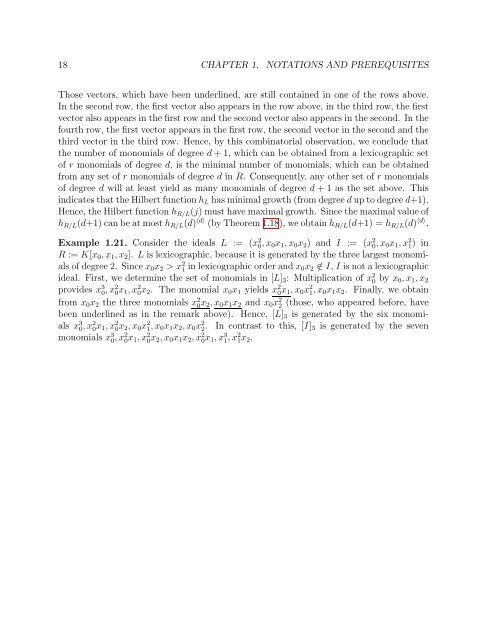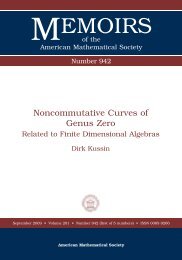University of Paderborn Department of Mathematics Diploma Thesis ...
University of Paderborn Department of Mathematics Diploma Thesis ...
University of Paderborn Department of Mathematics Diploma Thesis ...
Create successful ePaper yourself
Turn your PDF publications into a flip-book with our unique Google optimized e-Paper software.
18 CHAPTER 1. NOTATIONS AND PREREQUISITESThose vectors, which have been underlined, are still contained in one <strong>of</strong> the rows above.In the second row, the first vector also appears in the row above, in the third row, the firstvector also appears in the first row and the second vector also appears in the second. In thefourth row, the first vector appears in the first row, the second vector in the second and thethird vector in the third row. Hence, by this combinatorial observation, we conclude thatthe number <strong>of</strong> monomials <strong>of</strong> degree d + 1, which can be obtained from a lexicographic set<strong>of</strong> r monomials <strong>of</strong> degree d, is the minimal number <strong>of</strong> monomials, which can be obtainedfrom any set <strong>of</strong> r monomials <strong>of</strong> degree d in R. Consequently, any other set <strong>of</strong> r monomials<strong>of</strong> degree d will at least yield as many monomials <strong>of</strong> degree d + 1 as the set above. Thisindicates that the Hilbert function h L has minimal growth (from degree d up to degree d+1).Hence, the Hilbert function h R/L (j) must have maximal growth. Since the maximal value <strong>of</strong>h R/L (d+1) can be at most h R/L (d) 〈d〉 (by Theorem 1.18), we obtain h R/L (d+1) = h R/L (d) 〈d〉 .Example 1.21. Consider the ideals L := (x 2 0, x 0 x 1 , x 0 x 2 ) and I := (x 2 0, x 0 x 1 , x 2 1) inR := K[x 0 , x 1 , x 2 ]. L is lexicographic, because it is generated by the three largest monomials<strong>of</strong> degree 2. Since x 0 x 2 > x 2 1 in lexicographic order and x 0 x 2 /∈ I, I is not a lexicographicideal. First, we determine the set <strong>of</strong> monomials in [L] 3 : Multiplication <strong>of</strong> x 2 0 by x 0 , x 1 , x 2provides x 3 0, x 2 0x 1 , x 2 0x 2 . The monomial x 0 x 1 yields x 2 0x 1 , x 0 x 2 1, x 0 x 1 x 2 . Finally, we obtainfrom x 0 x 2 the three monomials x 2 0x 2 , x 0 x 1 x 2 and x 0 x 2 2 (those, who appeared before, havebeen underlined as in the remark above). Hence, [L] 3 is generated by the six monomialsx 3 0, x 2 0x 1 , x 2 0x 2 , x 0 x 2 1, x 0 x 1 x 2 , x 0 x 2 2. In contrast to this, [I] 3 is generated by the sevenmonomials x 3 0, x 2 0x 1 , x 2 0x 2 , x 0 x 1 x 2 , x 2 0x 1 , x 3 1, x 2 1x 2 .
















